
KALLISTO
Chasing Curiosity ✨
Hello!
Are you interested in getting involved with the
Kallisto team? Look no further! 🌟
Here are the application form links so that you can become
part of either the Executive Board or the Core Team 🌙
We look forward to seeing your application!

KALLISTO: The Blog
Welcome to our blog! Chceck out our posts below! 💫
BLOG ARTICLES
NOVEMBER BLOG POSTS

To Infinity and Beyond!
You are one of over seven BILLION people who lives in a big blue marble that we call our home: Earth. However, our planet occupies just a tiny fraction of the Solar System, governed by the Sun, our only astronomical star, and one of the many more celestial bodies - which our galaxy, the Milky Way, contains a few a handful. As such, the universe is vast, filled with astral entities, anxiously waiting to be found by us.
With all the eternal bounds to ponder on, it is natural to feel insignificant. After all, there is so much to explore and discover. For this purpose, Kallisto presents you with the wonders of what the universe has in store for you! A preview that lets you have a taste of what lies to infinity and beyond our reach. Scaling from the celestial bodies found in our very own Solar System, to our local group of galaxies, even what exceeds the large expanse - there is always something to learn and explore.
What’s Out There in our Solar System?
Jupiter's Moons
As of this moment, Jupiter has 79 moons. Yes, seventy-nine. Nonetheless, out of all those 79 moons, there are four exceptional ones, called the Galilean Moons. They were all discovered by the astronomer, Galileo Galilei in 1610, hence the nickname, “Galilean Moons.”
Ganymede
First, we have Ganymede, the biggest out of the Galilean Moons. It spans 5,268 kilometers in diameter, making it more massive than the planet Mercury. Its surface composes of rocky material and ice. Furthermore, it sports broad and bright ridges and grooves that seem to cut through the darker ones on its surface. The division is the result of two types of terrain on Ganymede’s surface. The bright areas are a younger terrain, while the darker areas are older. Aside from that, this moon carries extensive, but few craters with it. Moreover, a unique trait about this moon is that it is the only known moon to host a magnetic field.
Aligned with that, it enables the moon to manifest auroras, similar to ones on Earth. To add, scientists believe that Ganymede may contain liquid water under its surface. It also has a fragile atmosphere made out of oxygen, but sadly, it’s too thin to support life.
Callisto
Meanwhile, we have the farthest Galilean Moon from Jupiter, Callisto. Sound familiar? (That’s us!) It is far enough that it doesn’t gravitationally interact with the other three moons. Aside from that, it’s also a little smaller than Ganymede and the planet Mercury, as it is only 4820 kilometers in diameter. Similar to Ganymede, Callisto has a rocky and icy surface.
Nevertheless, unlike Ganymede, it has numerous craters. Callisto litter the surface, classified as the most heavily cratered object in the Solar System. Since it has copious amounts, they theorized that Callisto has little to no geologic activity to erode the craters away, resulting in its surface to be one of the oldest in the Solar System, estimated at around 4 billion years old. Some of these craters cap with ice, which illustrates why Callisto has bright spots along its exterior. In its interior, Callisto may host a salty underground ocean 250 kilometers underneath - a salty ocean implies that the moon may potentially host life.
Europa
Europa is the smallest out of all the Galilean moons, spanning only 3121 kilometers in diameter. Its surface consists of water ice, which may be 15-25 kilometers thick. Additionally, Europa’s body is incredibly smooth, which is odd because it has no volcanoes to erode any craters away. Instead, it has long cracks and complex ridges. These fractures may be the outcome of water from its interior flowing upwards. The rise of water not only causes these bursts, but it also forms new, smooth surfaces. These cracks also serve an exciting purpose. In 2013, NASA found evidence that Europa may be actively venting water into space from its damages, which means that the moon is geologically active. Since the cracks come from water in Europa’s interior, scientists also think it hosts an underground ocean 60-150 kilometers deep, containing twice as much water as Earth’s oceans, making Europa one of the most promising places to look for life outside of our planet.
IO
Last but not least is Io. Io is the closest Galilean moon to Jupiter. Aside from that, it is only 3643 kilometers in diameter, making it just a bit larger than Earth's moon. Its predominantly yellow color comes from the sulfur and silicate rock on its surface. However, what sets Io apart from the others is the presence of volcanoes. Io is the most volcanic object in the Solar System, as over 400 volcanoes are active on its surface. These volcanoes are why Io has no impact craters since molten lava from them can easily cover them up. Knowing all that, why is Io so volcanically active? This surprising amount of activity is due to Jupiter's gravitational pulls and two other Galilean moons (Europa and Ganymede). These bodies pull on either side of Io, generating enormous heat and energy within it. Sadly, because of the tremendous amount of heat and volcanic activity in Io, it has no water, unlike the other moons.
The Sun
Despite being an object, we see and feel every day; there is countless more to be recognized about the Sun. As we all know, it is the most prominent object in the Solar System, taking up about 99.8% of the Solar System's mass. It has a 605,508 kilometers radius, making it big enough for one million Earths to fit inside. Unfortunately, we don't get to see our star's actual size due to it being around 150 million kilometers from us. The thing is, even though the Sun is unimaginably big, it is only classified as a yellow dwarf star, implying that the size of our Sun is pretty average compared to other stars out there.
The Sun has six regions: the Core, Radiative Zone, Convective Zone, Photosphere, Chromosphere, and Corona. First, we have the Sun's core, the hottest part of the Sun. It sits at about 15 million degrees Celsius, which is hot enough for thermonuclear fusion. Thermonuclear fusion is a process every star goes through, where atomic nuclei fuse into heavier elements. Thus, it releases enormous amounts of energy, and it produces all heat and light that the Sun emits.
Further out from the core is the Radiative Zone. Through radiation, all energy from the center goes to this zone. Next, we have the Convective Zone. This zone is much more relaxed than the core, as it's around 2.5 million degrees Celsius instead. Ionized atoms, also known as Plasma, move up from this zone as well. Afterward, we have the Photosphere, also known as the Sun's surface. The Photosphere is now even colder, at 10,000 degrees Celsius. However, it's still hot enough to boil graphite and diamonds. It is 500 kilometers thick, and it consists of gases, not solids. Most of the radiation here escape outwards, and we see that radiation as sunlight. Next, we move on to the regions located in the Sun's atmosphere. The Chromosphere contains light that is usually too weak to be seen. During Solar eclipses, though, it is present as a red rim around the Sun. Lastly, we have Corona. (No, not COVID-19!) It can only be seen during solar eclipses, looking like a white crown shaped like flower petals. Strangely enough, the Sun's atmosphere heats the higher you go, reaching temperatures as high as 2 million degrees Celsius. However, this situation is considered a scientific mystery.
What’s Out There in the Galaxy?
Sagittarius A* Black Hole
Black holes have a gravitational field so strong that even light cannot escape it, resulting in a hole darker than the night. There are two kinds of black holes: the baby black holes and the giant or supermassive black holes. Supermassive black holes are theorized to be in the center of every galaxy. These factors considered Sagittarius A, a black hole in the center of our universe, a supermassive one.
Knowing all this, why is a black hole's gravitational field unbelievably strong? Well, the reason for this all boils down to how it was formed in the first place. When a star dies, its gravity overtakes it, and the star collapses. Massive stars (more gigantic than our Sun) end up going supernova. As this happens, the star's surface collapses into itself, creating a black hole. A black hole is usually several times smaller than its parent star, but it still retains the star's mass. Since a star's mass has crammed into a very, very small area, the gravitational pull of a black hole is powerful. So strong that even light cannot escape its influence. Fortunately for us, less than 1% of material in Sagittarius A's effect reaches its event horizon or the point of no return. Most material ejects from the black hole, so our galaxy has a meager chance of being devoured.
UY Scuti
Discovered in 1860 by German astronomers, UY Scuti is the biggest known star in the Milky Way galaxy. It is 5,219 light-years away, and it’s located in the constellation of Scutum. Sadly, we don’t quickly realize how big this star is due to its distance from us. UY Scuti is a Red Hypergiant with a radius of 1.1883 BILLION kilometers, which is over 1700 times bigger than the Sun’s. If this massive star were to replace the Sun in our Solar System, its surface would reach Jupiter and Saturn’s orbits, devouring Earth in the process. Aside from being way bigger than the Sun, it’s also way brighter. UY Scuti has an absolute magnitude of -6.2, making it 340,000 times more luminous than our Sun. It can change its brightness, though, and from Earth, it can be viewed as a pulsating star. Aside from that, its surface temperature is about 3,365 Kelvin, or 3091 degrees Celsius, making it a lot cooler than the Sun’s surface. Even so, it still has a very similar composition to the Sun’s (Hydrogen, Helium, and heavier elements).
But why is UY Scuti so big? Was it always like this? In actuality, no. UY Scuti wasn’t this big before. Before turning into a Red Hypergiant, UY Scuti must have been a Blue Main-sequence star. Blue Main-sequence stars are much smaller than Red Hypergiants but are still more massive than our Sun. Like Blue main-sequence stars, average stars maintain a balance between two opposing forces: gravity and internal heat. This balance keeps the size of the star. Inside its core, pressures and temperatures are hot enough to fuse the nuclei of atomic elements. This fusion releases a lot of energy and creates heavier elements. For example, Hydrogen atoms will fuse into Helium atoms. Helium atoms will fuse into Carbon atoms, etc. Heavier elements like Carbon take higher temperatures and pressures to merge, but since UY Scuti has a high enough mass, it can fuse elements up until Iron. However, the problem starts when a star runs out of Hydrogen atoms to fuse. When this happens, Helium fusion begins, disrupting the balance between its two opposing forces. Because of this, its surface swells up into a Red Supergiant or even Hypergiant. These events result in UY Scuti’s present appearance. Since UY Scuti is believed to have started fusing Helium, this makes it an aging star that will eventually go supernova.
What’s Out There in our Local Galaxy Group?
Andromeda Galaxy
Andromeda Galaxy, also known as Messier 31, is our nearest galactic neighbor despite being about 2.5 million light-years away. It’s also a spiral galaxy, much like ours, containing around a trillion stars. Andromeda Galaxy’s central area is full of yellowish stars. It also has a ring of dust present in its center, which may prove that the galaxy has had previous collisions. The universe also has a blue ring full of clusters of young (and blue) stars. That is also the region where new stars form. Since Andromeda Galaxy is the closest galaxy to us, it can be observed by the naked eye. This galaxy is best observed in a dark area in November.
The real exciting thing about this galaxy is… it’s heading towards us. That’s right - the Andromeda galaxy is approaching the Milky way at 112 kilometers per second. That may be fast for us, but on the scale of the universe, it’s not at all since the collision won’t happen until approximately 4 billion years later. It will take another 2 billion years after that for it to fully merge with the Milky Way, forming the Milkdromeda elliptical galaxy. By that time, though, the Sun will have already expanded into a Red Giant, consuming all life from Earth, so humans probably won’t be able to see the collision from our home planet.
Tarantula Nebula
The Tarantula Nebula, also known as 30 Doradus, is the biggest known nebula. It is the brightest and most active star-forming region that spans over a thousand light-years across. It's located in Dorado's constellation, otherwise known as The Dolphinfish, a part of the Large Magellanic Cloud, a dwarf galaxy. The Tarantula Nebula contains many star clusters such as NGC 2070, Hodge 301, NGC 2060, and NGC 2100. Many of those clusters contain stars that have gone supernova. It also includes a supernova called 1987A, which burned with the energy of 100 million Suns for months.
What’s out of our reach? Out there?
Bootes Void
Also known as “The Great Nothing,” the Bootes Void is one of the largest voids in the observable universe. It’s located around the “Ploughman” constellation, and it’s a rough sphere of around 280 million light-years in diameter. Aside from that, the Void is a whopping 700 million light-years from Earth.
The Bootes Void only contains 60 galaxies. Compared to the Virgo Supercluster with around 2000 galaxies, the Void is empty compared to the rest of the universe. It’s so dark and open that, according to Greg Aldering, if the Milky Way galaxy was situated in its center, we wouldn’t have known of the existence of other galaxies until the 1960s.
The Great Attractor of the Laniakea Supercluster
The Laniakea Supercluster is an enormous cluster of galaxies spanning 500 million light-years in diameter. Our Milky Way galaxy, our local galaxies, and 100,000 other galaxies are a part of this giant supercluster. Keep in mind, though, galaxies here are not distributed evenly. Through gravity, they tend to group to form small clusters (like our local group), connecting to other galaxy clusters through gravity. This creates an even bigger cluster of galaxies until a supercluster, much like Laniakea, is formed.
Knowing all this, what exactly is the Great Attractor? The Great Attractor is a gravitational anomaly located in the Laniakea Supercluster that pulls all of its galaxies. It is around 150 million light-years away, yet our galaxy is approaching this anomaly at approximately 2,160,000 kilometers per hour. To put this into perspective, if the Earth were to revolve around the Sun that quickly, one year would be equal to 18 days only. Unfortunately, a part of the Great attractor is hidden behind the Milky Way’s Zone of Avoidance, an area of the sky jam-packed with so much dust and gas from the Milky Way that it covers everything behind it. Because of this, the mysterious force behind the Great Attractor cannot be identified.
What’s… over here?
Indeed, the universe filled with so much wonder and mystery from every nook and cranny. Furthermore, there is so much more that needs to be studied and explored. Through the emergence of our own Philippine Space Agency, our organization, aka Kallisto, and our various projects, we hope that you may learn of the wonder of the universe and everything beyond it! (Call us a black hole, because we have all the info you never knew you wanted to know concentrated in one place!) With projects such as our monthly newsletter and our movie and song recommendations, may we spark a curiosity within you to learn more? The interest to get up and explore what lies in the skies, and to chase the stars.
References
Brown, D. (2015). What’s the biggest star in the Universe?. Retrieved on September 12,
2020, from https://phys.org/news/2015-12-biggest-star-universe.html
CrashCourse. (2015). High mass stars: Crash course Astronomy #31 [Video]. Retrieved
September 12, 2020, from https://www.youtube.com/watch?v=PWx9DurgPn8
CrashCourse. (2015). Jupiter’s Moons: Crash Course Astronomy #17 [Video]. Retrieved
September 10, 2020, from https://www.youtube.com/watch?v=HaFaf7vbgpE&t=191s
Dvorsky, G. (2012, June 6). Behold the Bootes void, the spookiest place in the cosmos. Retrieved
September 12, 2020, from
https://io9.gizmodo.com/behold-the-bootes-void-the-spookiest-place-in-the-cosm-5923493
EarthSky. (2014, September 3). Astronomers define boundaries of our home supercluster and
name it Laniakea. Retrieved on September 12, 2020, from https://earthsky.org/space/laniakea-is-the-new-name-for-our-home-supercluster-of-galaxies
ESO. (2018, May 30). Tarantula Nebula : A crowded neighborhood. Retrieved on September 12,
2020, from
https://phys.org/news/2018-05-tarantula-nebula-crowded-neighborhood.html
Kettley, S. (2020, July 15). Space mystery: What is this object stretching 1.4 billion
light-years across space?. Retrieved September 12, 2020, from
https://www.express.co.uk/news/science/1309744/Space-mystery-astronomers-detect-South-Pole-Wall-filament
Mahoney, T. (2020, May 7). The Great Attractor explained, Retrieved on September 12, 2020,
from https://medium.com/predict/the-great-attractor-explained-bea88869f852
NASA. (2019). Black Holes. Retrieved on September 12, 2020, from
https://science.nasa.gov/astrophysics/focus-areas/black-holes
NASA. (2019). Callisto. Retrieved September 12, 2020, from
https://solarsystem.nasa.gov/moons/jupiter-moons/callisto/in-depth/
NASA. (2019). Enceladus. Retrieved September 12, 2020, from
https://solarsystem.nasa.gov/moons/saturn-moons/enceladus/in-depth/
NASA. (2019). Europa. Retrieved September 12, 2020, from
https://solarsystem.nasa.gov/moons/jupiter-moons/europa/in-depth/
NASA. (2019). Ganymede. Retrieved September 10, 2020, from
https://solarsystem.nasa.gov/moons/jupiter-moons/ganymede/in-depth/
NASA. (2019). Io. Retrieved September 12, 2020, from
https://solarsystem.nasa.gov/moons/jupiter-moons/io/in-depth/
NASA. (2019, October 23). Messier 31 (The Andromeda Galaxy). Retrieved on September 12,
2020, from https://www.nasa.gov/feature/goddard/2017/messier-31-the-andromeda-galaxy
NASA. (2019). Our Sun. Retrieved on September 12, 2020, from
https://solarsystem.nasa.gov/solar-system/sun/in-depth/
NASA. (2017, August 29). Supermassive Black Hole Sagittarius A*. Retrieved on September 12,
2020, from
https://www.nasa.gov/missionpages/chandra/multimedia/black-hole-SagittariusA.html
NASA. (2020, January 28). Tarantula Nebula Spins Web of Mystery in Spitzer Image. Retrieved on
September 12, 2020, from
https://www.nasa.gov/feature/jpl/tarantula-nebula-spins-web-of-mystery-in-spitzer-image
NASA. (2019). Titan. Retrieved on September 12, 2020, from
https://solarsystem.nasa.gov/moons/saturn-moons/titan/in-depth/
Overbye, D. (2020, July 10). Beyond the Milky Way, a galactic wall. Retrieved on September
12, 2020, from https://www.nytimes.com/2020/07/10/science/astronomy-galaxies-attractor-universe.html
Sokol, J. (2016, October 18). Space is full of gigantic holes that are bigger than we expected.
Retrieved on September 12, 2020, from
https://www.newscientist.com/article/2109398-space-is-full-of-gigantic-holes-that-are-bigger-than-we-expected/
Redd, N. T. & Howell, E. (2019, March 11). The Andromeda Galaxy (M31): Locations, characteristics
& Images. Retrieved on September 12, 2020 from
https://www.space.com/15590-andromeda-galaxy-m31.html
UY Scuti facts. (2020). Retrieved on September 12, 2020, from
https://nineplanets.org/uy-scuti/
Image sources:
NASA/JPL. (2014). Europa’s stunning surface [Image]. Retrieved on September 19, 2020,
from https://solarsystem.nasa.gov/resources/204/europas-stunning-surface/?category=moons/jupiter-moonseuropa
NASA/JPL. (2019).
Ganymede [Image]. Retrieved on September 19, 2020, from
https://solarsystem.nasa.gov/moons/jupiter-moons/ganymede/in-depth/
NASA/JPL/DLR. (2001). Global Callisto in color [Image]. Retrieved on September 19, 2020,
from https://solarsystem.nasa.gov/resources/811/global-callisto-in-color/?category=moons/jupitermoonscallisto
NASA/JPL - Caltech. (2017). The galaxy next door [Image]. Retrieved on September 22, 2020,
from https://www.nasa.gov/missionpages/galex/pia15416.html
NASA/JPL - Caltech. (2020). Tarantula nebula Spitzer 2-color image [image]. Retrieved on
September 22, 2020, from
https://www.jpl.nasa.gov/spaceimages/details.php?id=PIA23646
NASA/JPL/University of Arizona. (1999). Global image of Io (true color) [Image]. Retrieved
on September 19, 2020, from https://solarsystem.nasa.gov/resources/808/global-image-of-io-true-color/?category=moons/jupiter-moons_io
NASA/SDO. (2017). Sun emits a solstice flare and CME [Image]. Retrieved on September 20,
2020, from https://solarsystem.nasa.gov/resources/386/sun-emits-a-solstice-flare-and-cme/
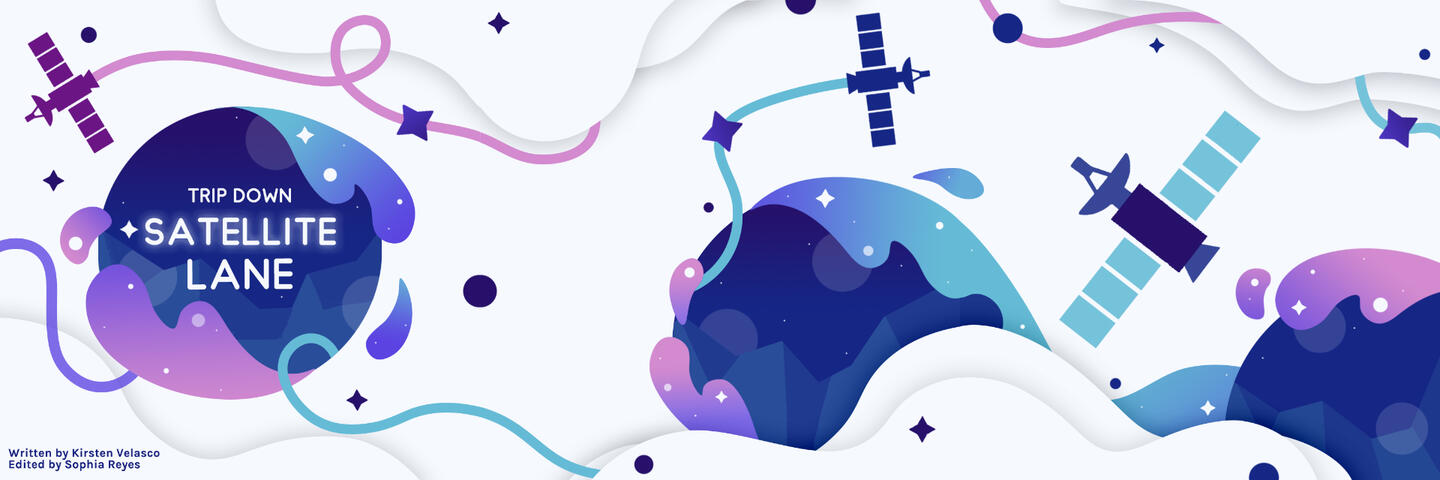
“Once in a blue moon.”
That saying is rarely used anymore, but it implies "not very often," just like the real Blue Moon. "What? The Blue Moon is real?" Yes, you may have thought of it as just another metaphor, but a blue moon is an actual phenomenon that we experience in the real world. (Though not as you expect them to!) Unfortunately, the moon isn't blue. It just indicates that it is "the 2nd of 2 full moons in a single calendar month." (earthsky.org) Did you know that we will be experiencing it soon? The next Blue Moon will happen on October 31 of this year, on the evening of Halloween. Pretty spooky, huh?
"But why are we talking about the moon?" you might be asking. "I thought this was about satellites?" And you'd be exactly right about that because the moon itself is a natural satellite of the Earth. "But aren't satellites just those big machines in space?" There's more to it than you may know!
Why are we talking about satellites?
World Space Week is an annual celebration of all things space started by the UN in 1999, designated to happen every October 4 to October 10. Following last year’s theme of “The Moon: Gateway to the Stars,” this year’s theme expanded from just the moon to all satellites, becoming “Satellites Improve Life.” As such, we now focus on the importance of satellites in our lives, how they function to help society progress and evolve.
But how do they help us advance and develop? And what is their purpose? Here’s a quick recap if you’re not familiar with the subject.
What is a “satellite”?
If you were astounded with that moon fact, chances are you're new to satellites, in which I say, welcome! You may have only considered satellites as those machines in space with the panels and the antenna, and you're not wrong. A satellite often refers to "a machine launched into space and moves around Earth or another body in space." (nasa.gov) The definition describes artificial satellites, otherwise known as human-made machines, so you are entirely correct in assuming that those machines are satellites; however, there is more than one kind of satellite in the sky.
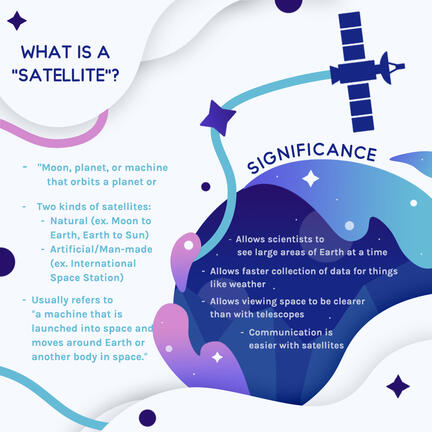
According to NASA's official website, a satellite is "a moon, planet or machine that orbits a planet or a star." Meaning that not only is every Moon a satellite to the planet they orbit around, but that every planet is a satellite of the Sun, which is the star of our solar system. So, in actuality, the Moon is the satellite of another satellite! Celestial bodies that also happen to be natural satellites because they occur naturally without humans' support.
Next, what are the primary functions of a satellite? Usually, they function for three things: (1) taking pictures of Earth, (2) taking pictures of other celestial bodies, and (3) transmitters for communication.

1. Taking Pictures of Earth
Satellites take pictures of the Earth for multiple reasons, one of which is for the weather. Ever wonder how they get those images of storms gathering into typhoons, monsoons, or hurricanes? Those are all satellite images. Photographs like those help meteorologists (and weather reporters alike) understand and relay information about the Earth's weather to people on TV or online to prime us on the precautions we may need to take for that particular day or week.
2. Taking Pictures of Other Celestial Bodies
What about other planets? We don't need to know the weather there, do we? Well, we don't, but it sure is crucial for scientists to comprehend. Planets that are not our own are (as of right now) uninhabited and unlivable, for us at least, but they are unexplored lands nonetheless. With their picture-taking expertise, satellites can get up close and personal with other planets that even humans have not reached or made contact with ever. An example of that is the Sun Orbiter, launched by the European Space Agency (ESA) to take the sun's closest pictures. These photos will help us learn the nature and characteristics of other planets to discover more about them and their history.
3. Communication
Ever wonder how live streams and live shows appear on your TV and gadgets in real-time, even if they're countries away? You have satellites to thank for that. We have communication satellites, whose only function is to receive and transmit data from one part of the world to another. They can take transmissions, such as GPS signals, TV signals, and international phone calls.
Satellites often don’t hit each other because scientists are very wary of their positions in space. Geostationary satellites, those that follow a specific spot on Earth even as the planet rotates, and Polar satellites, those that go from pole to pole, are all on different orbits and altitudes while still maintaining a balance between their speed and Earth’s gravity. They are all specifically designed to avoid a collision. However, the chances of that increase as more and more satellites launch into the sky.
Ready to take notes? So… where did it all begin?
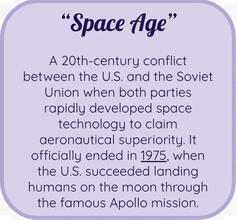
It all began in the Soviet Union in 1957. They had just finished developing a new kind of machine specifically for space. They called the newly-made spacecraft “Sputnik 1,” meaning “satellite,” and it would be the first artificial satellite to travel into space. After a successful launch on October 4, 7:48 pm, Sputnik received that title and began what was known as the “Space Race.”
A month later, on November 3, the Soviet Union launched “Sputnik 2” as a direct continuation of its first launch. Sputnik 2 is best known as the first satellite to successfully carry a living being, a dog known as Laika the Space Dog! This satellite later burned up in April in the upper atmosphere, with Laika passing away a few days after the original launch.
These launches by the Soviet Union prompted the U.S., and its space agency (which you may be familiar with!) the National Aeronautics and Space Administration, better known as NASA, ordered the creation process of their artificial satellite, which had been in the making since before Sputnik 1. The “Explorer 1” was going to be America’s first and the world’s third artificial satellite to be launched into space and was launched the year after, 1958, on January 31.
Besides being the U.S.’s first step in the Space Race, it also identified what is known as the “Van Allen Belt,” found by James Van Allen, a physicist at the University of Iowa. The Van Allen Belt is a collection of rows of highly energetic particles trapped by the Earth’s magnetic field, thus surrounding the planet. This belt traps solar winds and thereby protects the atmosphere from its otherwise adverse effects.
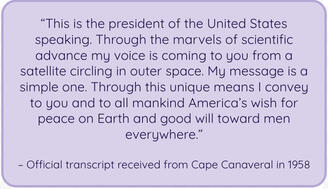
Near the end of 1958, on December 18, the U.S. launched the “Signal Communications by Orbiting Relay Equipment” satellite or “SCORE,” the world’s first communications satellite advantage of the ionosphere for transmission and reception of signals. It made its mark when it was used to broadcast a Christmas message from then U.S. President Dwight D. Eisenhower the day after it was launched.
The next year, 1959, on August 7, NASA launched “Explorer 6” or the sixth in the series of Explorer satellites up to that point. Explorer 6 is known for bringing back the first picture of Earth taken via satellite. With that said, the discovery further moved the idea of taking pictures of other planets and celestial bodies in space, which still occurs today, 61 years later!
Following Explorer 6 were three critical satellites launched by NASA, all in the same year. In 1960, NASA first launched the “Television Infrared Observation Satellite,” abbreviated to “TIROS-1” on April 1. This satellite was used to send back the first TV picture of Earth via satellite, further proving satellites’ usefulness in space documentation. Next was the “Echo,” launched on August 12, as the first radio communications satellite, which also reflected microwave signals. Last from the notable satellites of that year was “Courier 18”, named “courier,” meaning “messenger,” the first telecommunications satellite that facilitated the broadcasting and rebroadcasting of messages like calls.
In 1962, two crucial NASA satellites were launched. The first was on July 10, named “Telstar 1”, the first active communications satellite, which receives a signal and amplifies it before sending it back to the ground again. Active communication satellites are the ones mostly used nowadays. On December 13, the second was named “Relay,” another communications satellite most known for international broadcasting, with its reach being from the U.S. to Japan.
Relay became the predecessor to 1964, launched on August 19, satellite “Syncom 3”, the first geostationary satellite. This satellite is known for broadcasting the 1964 Olympic Games, taking place in Tokyo, Japan. This led to the creation of “Intelsat III” in 1969 on July 26, known for live broadcast TV and as a commercial global communications satellite.
Now, all this talk of NASA makes it sound like a very one-sided Space Race but fast-forward to 1971, and on April 19, the Soviet Union launched “Salyut 1,” meaning “salute,” the world’s first space station. It took 27 years, or until 1998, for them to launch. This satellite is the “International Space Station” or (ISS) and was officially launched on November 20 as a joint project between the U.S., the European Union, Russia, Japan, and Canada. It functions as a lab for microgravity and other space environments, as well as your usual satellite.
Let's catch up on the present satellites launched most recently. In 2019, the ESA launched “CHEOPS” or the “Characterizing Exoplanets Satellite” on December 18, intending to study the nature and characteristics of exoplanets around nearby stars. Earlier this year, in February, they also launched the “Solar Orbiter,” which (as mentioned previously) has the goal of studying the surface of the sun and is capable of taking the closest pictures of the sun possible.
So what now?
Now, you are aware of the very summarized and simplified history of artificial satellites! Good job, and congratulations on reading this far! While artificial satellites' history seems focused on the U.S. and Russia, other countries over the Space Race and present-day have had and continue to have their space initiatives. Here are some highlights from those!
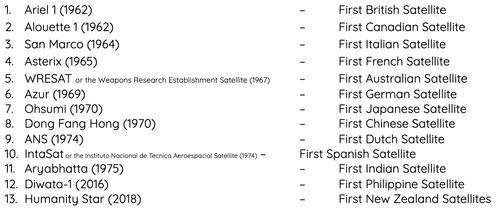
Satellites have existed for 63 years now, and the world continues to develop thanks to them. I encourage you to learn more on your own about these other satellites, and even those that weren't mentioned, like the Landsat series of satellites, the Uhuru, or the Webstar, all of which have had an impact on the way we communicate now. Satellites of all kinds and types have contributed a considerable amount to the way we live and connect today. Honestly, I think we can say that yes, "Satellites Improve Life."
References
ESA. (n.d.). Cheops. Retrieved on October 15, 2020, from https://www.esa.int/ScienceExploration/SpaceScience/Cheops
ESA. (n.d.). Solar orbiter. Retrieved on October 15, 2020, from https://www.esa.int/ScienceExploration/SpaceScience/Solar_Orbiter
Howell, E. (2018, May 11). Van Allen Radiation Belts: Facts and Findings. Retrieved on October 19, 2020, from https://www.space.com/33948-van-allen-radiation-belts.html
Howell, E. (2020, September 30). What is a Satellite? Retrieved on October 15, 2020, from https://www.space.com/24839-satellites.html#:~:text=A%20brief%20history%20of%20artificial%20satellites&text=3%2C%201957%20the%20Soviets%20launched,31%2C%201958.&text=(Other%20stations%20followed%2C%20such%20as,and%20the%20Soviet%20Union's%20Mir.)
NASA. (n.d.). An Early History of Satellites. Retrieved on October 15, 2020, from https://www.jpl.nasa.gov/infographics/uploads/infographics/full/11182.jpg
NASA. (2017). What is a satellite? Retrieved on October 15, 2020 from https://www.nasa..gov/audience/forstudents/5-8/features/nasa-knows/what-is-a-satellite-58.html
NOAA. (n.d.). Ionosphere. Retrieved on October 15, 2020, from https://www.swpc.noaa.gov/phenomena/ionosphere#:~:text=The%20Ionosphere%20is%20part%20of,used%20for%20communication%20and%20navigation
Mann, A. (2019). What Was the Space Race? Retrieved on October 19, 2020, from https://www.space.com/space-race.html#:~:text=The%20space%20race%20was%20a,to%20show%20superiority%20in%20spaceflight
Science Learning Hub. (n.d.). History of satellites. Retrieved on October 15, 2020, from https://www.sciencelearn.org.nz/resources/1905-history-of-satellites-timeline

Introduction
In 1977, NASA launched Voyagers 1 and 2. These spacecraft were created to explore the outer planets, namely Jupiter, Saturn, Uranus, and Neptune. The two probes would not return to Earth and would only pass by the planets they would visit. After that, they would head off into interstellar space. In case they would encounter any intelligent life along the way, the probes each carried a golden disk that would tell intellectual life about us and where we are, such that they could find us and learn who we are.
On the golden disks were instructions on how to find us and how to decode them. The disks contain 116 images about who we are and our place in the universe and various audio samples of human languages and activities and other sounds on Earth. The probes’ discs will last for over a billion years, long after we are gone/evolve into something unrecognizable.
So, what if we sent another Voyager probe out into interstellar space?
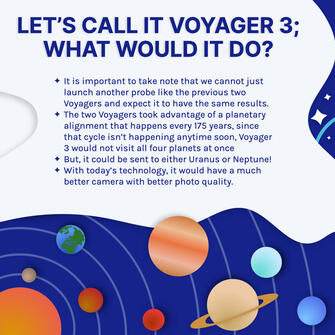
Let’s call it Voyager 3; What would we put into Voyager 3’s golden disc or an equivalent? Well, let’s find out.
We cannot just launch another probe like the previous two and expect it to have the same results. The two Voyagers took advantage of a planetary alignment that happens every 175 years, such that they could use the gravity of one planet to propel them to the next. Since that cycle isn’t happening anytime soon, Voyager 3 would not visit all four planets at once. However, it would probably be sent to either Uranus or Neptune, as we have already explored Jupiter and Saturn multiple times. With today’s technology, it would have a much better camera with better photo quality than the previous probes and updated instruments to make more discoveries of those planets.

So let us assume that Voyager 3 contains a disk similar to the two Voyager probes’ disks and is decoded in a similar manner, but with more storage capacity given today’s technology. What sounds, pictures, and, perhaps, videos would we put in it?
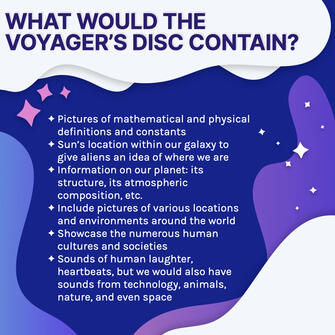
We would include pictures of mathematical and physical definitions and constants. Aliens would likely not understand our biology or chemistry because we have different biological structures or are composed of different molecules and compounds. However, they would understand mathematics as constant throughout the cosmosーtwo plus two is equal to four, no matter where you are in space.
We would show our Sun’s location within our galaxy to give aliens an idea of where we are. We would also show pictures of the Sun, planets, and moons in our Solar System and our data on them. We would also point out where Earth is, after which we would showcase information on our planet: its structure, its atmospheric composition, etc. Moreover, we would show them the chemical composition of our DNA to show them that we are a carbon-based species and composed of it. With that, more information on human anatomy and physiology, from what our cells are like, to the various body systems we are composed of, to human reproduction and development, and more.
After showcasing pictures of our location in the universe, our mathematics, physics, chemistry, and the details of our anatomy and physiology, we could then present them with various pictures of who we are, where we are, and what we are like as humans. A committee that decided on the contents of the record, headed by Carl Sagan, took special care to ensure that no pictures of war, crime, religion, ideologies, poverty, or disease would be included; for this probe, we would do the same.
We would show pictures of various locations and environments around the world, from oceans to deserts. Since our disc would be capable of storing videos, it would also show multiple videos of what these places are like, complete with both video and sound. It would also showcase various pictures of the biodiversity of living organisms from all six domains of life.
We would also showcase what various human cultures and societies are like and humanity’s technological achievements. Some examples would be pictures and videos of families and humans interacting, social activities like sports or eating, humans of different cultures, buildings and monuments like the Taj Mahal, and some technologies like the space station or airplanes.
The two Voyager probes contained various sounds of Earth: from those made by animals or nature to all kinds of musicーboth Eastern and Western of all periodsーto greetings from Earth in 55 different languages. Voyager 3’s disc would have much more storage allowing us to include more sounds and music. For one, we would include greetings in more than the original 55 languages and include more musical varieties and modern music, keeping in mind that they must not contain themes or messages about war, religion, politics, and the like.
In terms of sounds, we would not only strive to include human sounds like laughter or heartbeats, but we would also have sounds from technology, animals, nature, and even space. Ann Druyan, the second wife of Carl Sagan, suggested that they record a person’s brain waves, such that extraterrestrials can potentially decode their thoughts. It was her brain waves that were recorded on the Voyagers’ golden discs. Similarly, for our disc equivalent, we could record brain waves, this time of more than one person so that aliens could see how humans’ thoughts differ from one another.
Conclusion
Ultimately, just like the Voyager probes before it, Voyager 3 would be one of humankind’s last relics and would continue to exist billions of years from now. The contents of its disc: the pictures, the sounds, and the videos will tell the story of us as a species, who we were, what we were, and where we were. If aliens find it, then it will be a time capsule, telling the cosmos and intelligent life we were like today. It will act as a reminder that somewhere out there, we exist, or once existed.
References
Gambino, M. (2012, April 22). What’s on Voyager’s golden record? https://www.smithsonianmag.com/science-nature/what-is-on-voyagers-golden-record-73063839/
Howell, E. (2018, March 1). Voyager spacecraft: Beyond the Solar System. https://www.space.com/17205-voyager-spacecraft.html
NASA. (n.d). Images on the golden record. https://voyager.jpl.nasa.gov/golden-record/whats-on-the-record/images/
Vox. (2015, November 1). The 116 images NASA wants aliens to see [Video]. YouTube. https://www.youtube.com/watch?v=NAN1kt4SG9E&t=5s
https://voyager.jpl.nasa.gov/golden-record/whats-on-the-record/images/